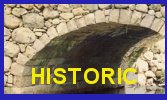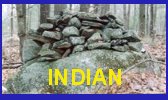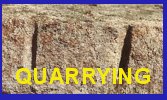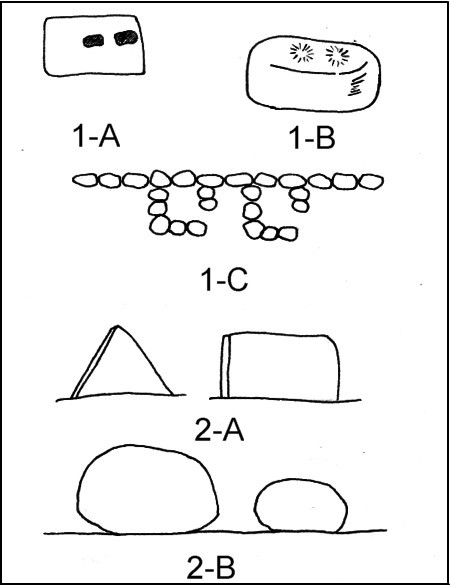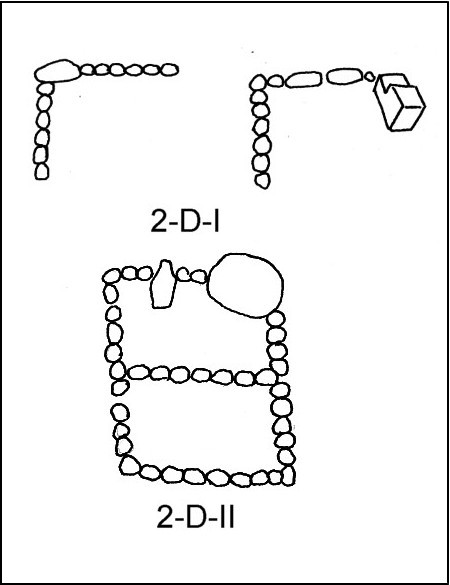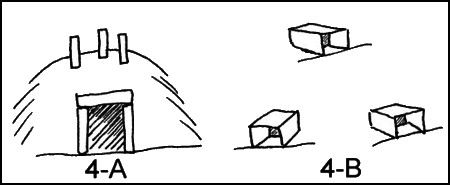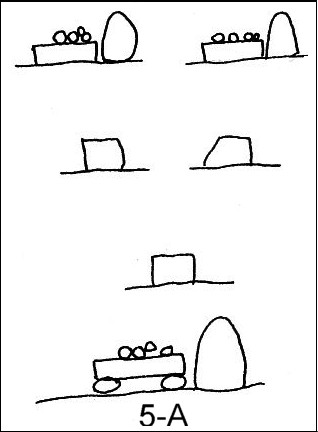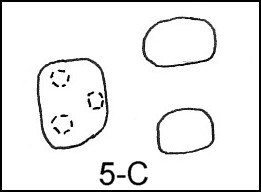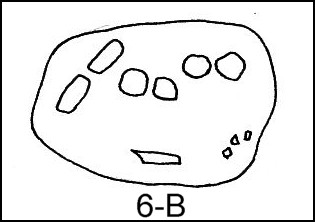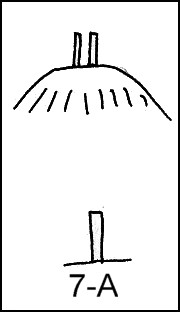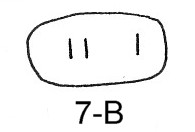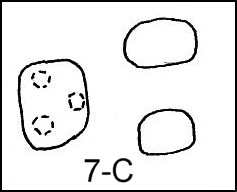|
Example #3 – Free standing small chamber or niche/cairn, Washington, MA
A purplish red hematite stone was placed above its entrance to block out and/or contain a spirit(s).
In Washington, Massachusetts there is a free standing cairn/niche or small chamber. “It was no more than three feet high and too small for a person.” Photograph shows it has a thin lintel stone with approximately three feet of stone above the lintel. “On top of the lintel stone of the Washington example, in the very center, was a large piece of hematite, purplish red in color and very heavy. Hematite was a source of red ochre.” (Rock Piles blog, article by Norman Muller, 2/1/06) The purplish red hematite was placed on top of lintel over the open front of niche or small chamber.
At America’s Stonehenge small chambers were larger than niches on average, niches are generally under two feet in length and height, and smaller than walk-in chambers with a height of over five feet. These small chambers were named storage chambers as all were large enough for a person to either crawl or stoop inside to retrieve ceremonial objects. The Washington, MA chamber’s size is in between the storage chamber size and niche size at America’s Stonehenge. At America’s Stonehenge most free standing niches and all storage chambers had some form of blocking symbolism built into the feature. Free standing niches were used to place an offering inside to call forth a spirit. Storage chambers were used to store ceremonial objects, and spirits in ethereal and in physical forms inside. The storage chamber brought the spirits from Upperworld and Underworld together inside the Underworld. It is not known what world the free standing niche was considered to be in. The spirits whether in a pottery vessel of water, a crystal, or invisible such as Underworld Spirit and Sun Spirit were vulnerable and needed protection. Plus, only invited spirits were allowed to be present inside such structures. That meant even a benevolent spirit such as Sun Spirit if it was not invited could not enter the structure. In addition there were disruptive spirits who also needed to be blocked from entering the structure. To do so, blocking symbolism in the form of colored stone and/or triangular shapes were used. At America’s Stonehenge the color white and later black were used to block out uninvited spirits. At the Washington, MA small chamber or niche purplish red hematite was used to block out uninvited spirits. What the structure is a small storage chamber or niche is unclear as author has no other data on the site for evaluation. No matter what the structure’s intended usage it appears the structure held a spirit(s).
Example #4 – Stone Cairn Excavation, Freetown, MA
Cairn with offering of raw red ochre to a Manitou spirit buried in the Underworld. Cairn also contains two deposits of charcoal. (Also, see Monolith A under Numbers for a second example of red ochre and fire/charcoal combined usage in a single feature.)
In Freetown, MA a cairn built on the ground was singled out from a much larger group of cairns to be excavated. It looked the same on the surface as many of the other on ground cairns. That is a neat pile of stone. Most cairns to date when excavated have yielded all stone. Cairns in general do not contain artifacts. The reason being the stones were the artifact. In this case, the stone in the cairn was more than a mere artifact it was used to bury other artifacts in the Underworld. A complete write-up on the excavation was done in Manitou (Mavor & Dix, 1989: 69-73). At the base of cairn two and a half feet below the surface was a standing stone twenty inches high worked into the shape of a lopsided diamond. The main excavators James Mavor and Bryon Dix felt the standing stone was a Manitou Stone, author agrees with them. A few inches higher within level of Manitou Stone and next to it was a cluster of pieces of red ochre. 120 pieces amounting to ten pounds were eventually collected a few pieces being scattered in the cairn. Within this cairn were different layers of small stones. Between a layer of small stones and a layer of large stone at a level between 8 and 12 inches below the surface two deposits of charcoal were found. Charcoal deposits were located on opposite sides of cairn and each was twelve inches diameter by four inches thick. “Carbon dates of 875 +/- 160 years ago and 790 +/- 150 years ago were determined from these charcoal deposits.” (pp. 72) ( Lab GX-9783 & GX-9784 [pp. 350]) The excavation report by Mavor and Dix states the soil profile was the same from 2½ feet depth up to 4 inches below top of surface. It matched a sample soil profile twenty-five feet away. The excavators felt the soil built up around the cairn over a very long period and that the cairn possibly pre-dates the earliest carbon date.
The two C14 dates show the two deposits of charcoal were placed in the cairn eighty-five to one hundred years apart. They are separate in depth and location from the red ochre deposit. In turn, red ochre deposit is next to but separate from the Manitou Stone. The charcoal and red ochre deposits suggest these items were used like artifacts and placed in the cairn at intervals.
The cairn’s location is on outer edge of cairn grouping. The Manitou Stone, a spirit stone embodied with a spirit marks outer edge of cairn. The red ochre deposit’s placement near to the Manitou Stone appears to be an offering to the spirit or the cairn and what it represents. Since it is higher up than base of Manitou Stone it was probably an offering made after the cairn had been established. Still higher up are the two charcoal deposits. There was no mention of burnt stone in the cairn which means the charcoal was produced from a fire elsewhere and brought to the cairn. At America’s Stonehenge fire with Fire Spirit was used to assist Sun Spirit in traveling from the ceremonial lodge in Middleworld up to the sun sphere low in the sky. It was also used to send a message to Upperworld’s North Spirit. Charcoal in the cairn was the remains of a fire and was some kind of offering. Charcoal is the most efficient substance to start a new fire. It like the red ochre may have been an offering to the spirit within the cairn.
The Manitou Stone is twenty inches high. Did it once stand sentinel within the cairn exposed to the surface? Was it buried under the cairn from the start? Irregardless, in time the Manitou Stone and its spirit were buried underneath and within the cairn, placing the unknown spirit in the Underworld. The spirit within the cairn places a spirit in residence at this cairn field ceremonial area. The two charcoal deposits suggest an offering was made at one hundred year intervals. (For a more in-depth write-up on one hundred year ceremonies see Numbers.) The offerings represented may have been the red ochre deposit, two charcoal deposits and various layers of stone. Different stone sizes were found in layers throughout the cairn as well as an elongated curved section. At America’s Stonehenge stone was a common offering substance used from around the start up circa 3000 years ago (BP – before present) and continued up to its closing in the historic period circa 1700 A.D.
Example #5 – Buried Ceremonial Feature, Caddy Park, Quincy, MA
Caddy Park was a buried feature with spirits, bags of red ochre and a red ochre powdered covering below and above the artifacts. It was excavated by T. Mahlstedt and M.M. Davis, and written up in Massachusetts Archaeological Society Bulletin V63 (1,2) 2002. Their conclusions were one of three possibilities: Burial; Cache for retrieval; Offering. In their offering conclusion they point out “we will never know to whom or for what this offering was made.” They go on to explore the possibly of the offering being made to Maushop a spirit who is thought to have made the southern coast of New England. Their conclusion as to the use of red ochre is “In this case, the red ochre-symbolizing the blood of a butchered whale-would be appropriate.” (p21-22)
The Caddy Park feature was a meticulously laid out selection of tools associated with fishing – plummets laid out as in a net surrounding a whale effigy carved on a gouge; hunting – small stemmed points; blades – for cutting meat or blubber; adzes – for wood working in making boats. In addition, there was a complete whale tail atlatl weight and a (broken) red slate half whale tail pendent. The meticulousness of the feature extended to including polishing tools, large tool blanks, small tool preforms and even a few flakes. The only type of tool missing was a tool to flake a blade or projectile point. The artifacts depict a complete set of tools for every aspect of whaling. There is a gouge for carving out a dugout canoe, to plummets to set out a net to capture a whale, knives to butcher a whale, a polishing stone to create a new pendant or atlatl, and performs and tool blanks to make new tools. This feature had a specific purpose and conveyed a story.
Four caches of tools were found, two appear to have been placed in bags with a large amount of powdered red ochre inside, and two appear to have been placed in a heavy concentration (bag) of red ochre (1) the gouges and adzes and (2) the green knife and edge tool/performs. Most tools throughout the feature had red ochre on their bottom side and top side suggesting red ochre was sprinkled on the ground before any tool or artifact was placed in the ground and again after the tools were placed in the feature before it was buried. Two colors were used green for one of the blades, and red for the broken slate pendent, and in the red ochre in bags and covering.
The image of a whale is the Whale Spirit. This placed the Whale Spirit in the feature. The whale image on the gouge has a line-grooved mouth and knob on top where the blowhole is located. It is missing a tail. The missing tail is represented by the whole whale tail atlatl which is dark with light marbling. Whales are dark with white marks on their tails. The broken whale tail symbol represented by the pendant is red which appears to represent blood. Broken objects are also known to have released the spirit of the animal or spirit within an object. Duality is common among Native Americans therefore the red blood and broken pendent could easily have worked together to represent a killed whale whose spirit was released. A whale’s tail is its most powerful body part it propels the whale in its travels through the ocean. The Whale Spirit within this feature was presented with two options. One was the whole whaletail (atlatl) to give the whale the power to escape capture. This allowed the whale to live and come back another year. The second was the broken whaletail (red pendant) to allow the whale to be captured so its body would feed the people.
This feature utilized the color red in the red ochre in two different ways:
I. There were several heavy concentrations of red ochre associated with caches of tools. The red ochre with the tool caches may have been offerings to the Whale Spirit within the feature.
II. The whole feature was (1) enclosed in red ochre and (2) buried under the ground. Placing the feature under the ground placed the whale (gouge) embodied with Whale Spirit and accompanying objects in the Underworld. The Underworld has many spirits wandering around. The various Underworld spirits needed to be kept out or blocked out of the feature to prevent interference. Red ochre was sprinkled below and over the feature totally enclosing the feature including the Whale Spirit. It blocked out uninvited spirits. At the same time the red ochre did not interfere with the Whale Spirit’s travels to and from the feature to the ocean to guide the whales. (Another example of an invited spirit being able to pass through a color used to block out uninvited spirits is seen in example #1.)
Example #6 – Common burials during Archaic and Early Woodland periods frequently used red ochre.
Burials place the body and spirit of a person under the ground in the Underworld.The Underworld has many spirits wandering around. Those spirits need to be blocked out of the burial and kept from interfering with the person’s spirit. To do so, the person’s body or bones, or simply the person’s spirit is buried in the Underworld enclosed in red ochre which blocks out uninvited spirits but allows the person’s spirit to move on when it is ready.
Conclusion
The color category was expanded beyond stone structure sites to be able explore its usage in other features and burials. Color had several purposes. It was used to represent a spirit, as an offering, and as a protective/blocking out symbol. It also had dual usage. In example #1 white was used to block out uninvited spirits. In example #2 white represented rain water and Rain Water Spirit. The white in each of these examples was used on the same site, America’s Stonehenge. In another structure on this site, the Lower East Side Storage Chamber, the color white was used in both capacities. (Gage 2006) The dual usage within a single chamber is similar to the triple usage within the Caddy Park feature where the broken red slate pendant represented the blood of a killed whale, and red ochre was used as an offering and as a protective symbol to block out uninvited spirits.
Color at stone structure sites is generally rare with the exception of America’s Stonehenge. Occasionally color is combined with shape and quartz.
|

